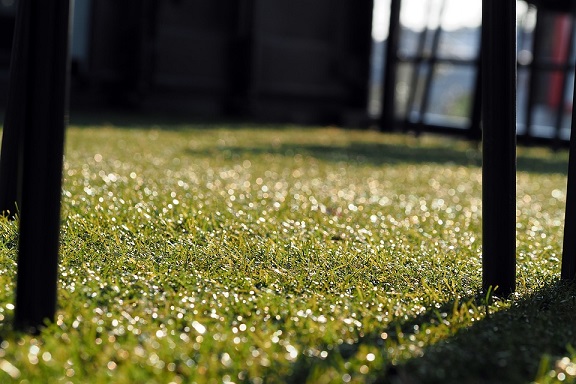
Gardening has long been a breeding ground for artificial stand-ins, from house plants to Christmas trees. Artificial grass is the most notable example, growing in popularity across the UK.
The question is: Is it all it’s cracked up to be? In this blog, we take a closer look and see how artificial grass weighs up against real grass.
Benefits of Artificial Grass
Artificial grass has seen a dramatic rise in popularity in recent years for a number of reasons. Here are a few of the biggest benefits of ditching the real deal in favour of a lookalike lawn.
Low-Maintenance
The primary reason many Brits are switching from genuine garden grass to artificial greenery is simple: it drastically reduces the amount of garden maintenance you'll need to undertake.
From mowing to weeding, real grass requires a lot of work to keep it looking presentable, particularly over the spring and summer months when grass growth is at its peak.
Leaving your garden to fend for itself is not a wise move. It’s a jungle out there and neglecting it will make your garden resemble one too.
Fake grass, on the other hand, provides an easy life, with no need for continuous care to maintain its unblemished aesthetic.
Durability
In addition to its year-round looks, it also boasts the ability to shake off the harshest of weather conditions, regardless of the season.
From baking sun to torrential rain to wintry frost, artificial grass won’t falter under the demands of Mother Nature.
What’s more, real grass often struggles under heavy footfall and a family barbeque can easily turn your beautiful lawn into a trampled mess or worse.
With artificial grass, you’ll have no such issue. While fake turf isn’t ideal on slopes, it is more than capable of withstanding a load of traffic during social gatherings.
Consistency
Real grass requires sunlight to maintain its constant colouration across the area of lawn. This can be troublesome, particularly when it comes to shaded areas.
Shady patches will naturally receive less sunlight and thus grow at a slower rate. Meanwhile, in colder weather conditions, this can even lead these patches to remain frosty, while the rest of the lawn basks in the winter sun.
Artificial grass won’t have these issues and will be uniform from fence to fence. Additionally, artificial grass is inherently immune to lawn disease, nor will it discolour should the family dog decide to give it an unwanted spray.
Benefits of Real Grass
While artificial grass does have its benefits, it’s hard to argue with the allure of real grass. Nature’s carpet has its own laundry list of natural pros that make it a fantastic choice for any garden. Here are the reasons FOR real turf in our real grass vs artificial grass battle.
Price
Artificial grass can be extremely pricy, particularly if you have a large garden area and want a surface that looks realistic.
When it comes to artificial grass, you really do get what you pay for: cheap isn’t good and good isn’t cheap.
High-quality artificial grass that looks the part will set you back anywhere between £15 and £30/m2.
By contrast, a few packets of grass seed and some Miracle-Gro will hardly break the bank beyond repair.
Even if you were to lay ready-made real turf, it could still cost you less than £5/m2, cutting the cost considerably.
Eco-Friendly
Real grass produces copious amounts of oxygen and actively contributes to a healthy environment around us.
In addition to that, it also plays a vital part in terms of wildlife, providing a natural ecosystem to many species of bugs and insects.
Replacing such a surface with a stand-in that doesn’t quite offer the same perks in terms of conservation can naturally have a negative effect on surrounding wildlife.
Experts caution that the faux substitute is actually a hindrance to the environment and a lack of natural grassland can negatively affect the carbon levels in the atmosphere.
Health Benefits
In addition to producing oxygen and contributing to cleaner air, natural grass has also been found to have a positive effect on overall health and well-being.
Real garden grass can be particularly beneficial for stress reduction and considered by many to be a natural regulator of cortisol.
What’s more, the act of gardening itself is also commonly cited as a stress-reducer, in no small part because the physical activity involved also provides a great form of low-intensity exercise.
Meanwhile, getting out in the open provides you with exposure to Vitamin D for a myriad of health benefits of its own.
READ MORE: How Your Garden Can Improve Your Mental Health
Artificial Grass vs Real Grass
When weighing up which option is best for you, it really does depend a lot on personal preference and individual needs.
When it comes to upkeep, there is no denying that artificial grass wins every time; however, maintenance isn’t everything.
After all, a stuffed animal doesn’t require much upkeep and still looks the part but it’s unlikely to be a preferred option to a living, breathing pet.
With real grass, however, comes real health and environmental benefits, as well as less pressure on your wallet.
So, we hope that our blog has helped your decision when it comes to artificial grass vs real grass, giving you a clearer idea of which will work best for you!
If you’re looking to get your garden in tip-top condition, why not drop us a line today? Call now on 0800 111 4958 or get in touch online using the button below and request a FREE garden survey today.
Get in Touch